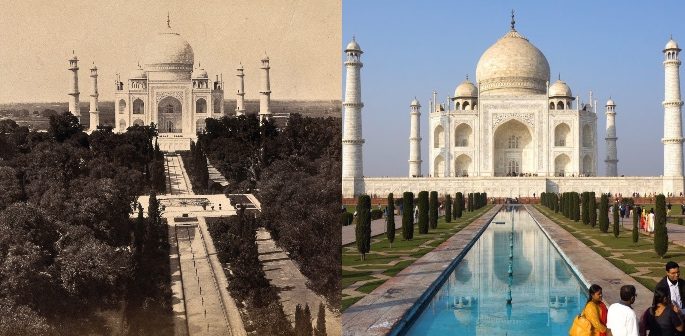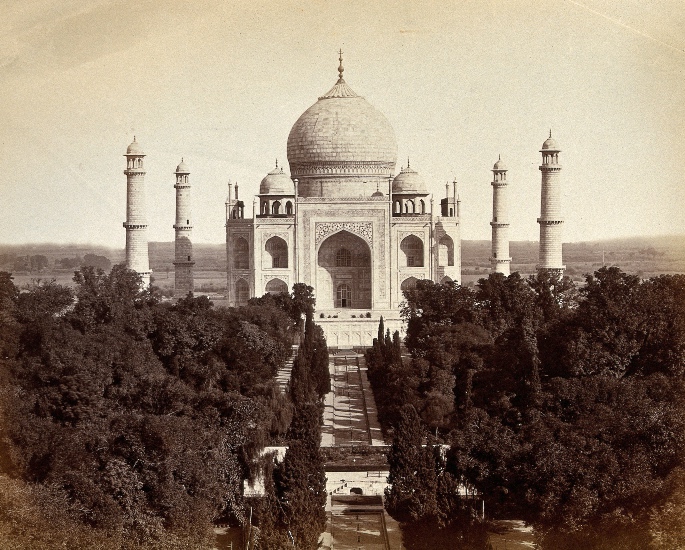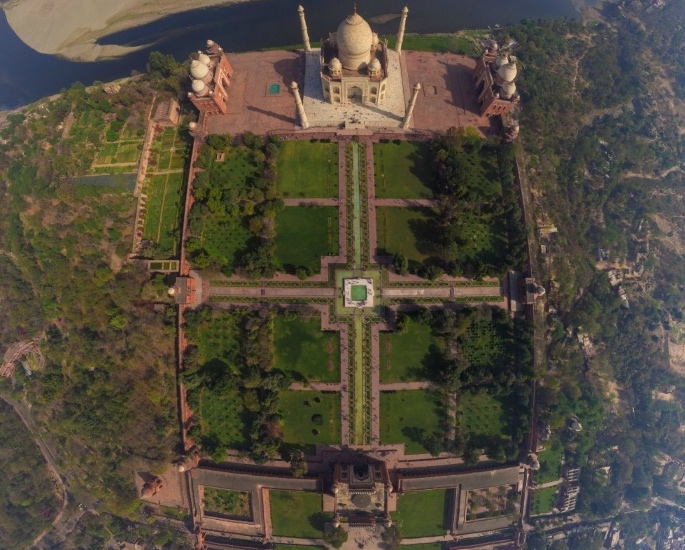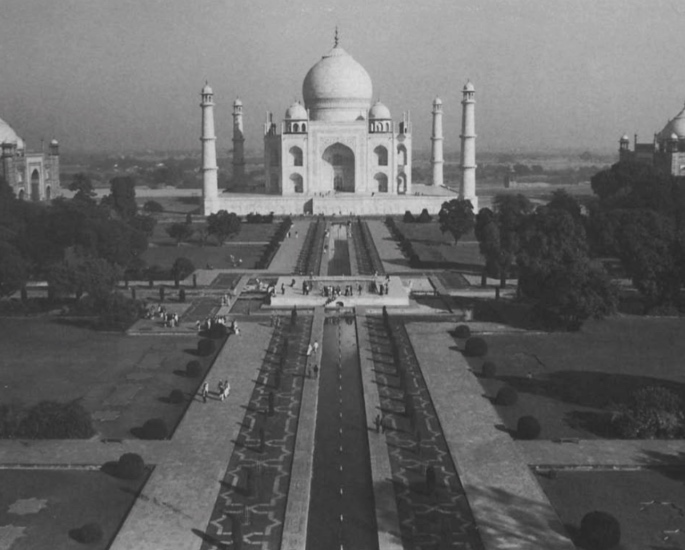“What else but great love could have inspired such great beauty?"
Gardens hold a great deal of significance aside from their aesthetic qualities and the 980ft Taj Mahal garden is no exception.
The Taj Mahal, one of the seven wonders of the world, is a world-famous Indian icon.
The magnificent white marble mausoleum and accompanying garden became a UNESCO World Heritage site in 1983. It is widely known for being:
“The jewel of Muslim art in India and one of the universally admired masterpieces of the world’s heritage.”
In the nineteenth-century, poet, Rabindranath Tagore referred to the Taj Mahal as a “teardrop on the cheek of eternity.” Tagore essentially referred to the complex as having an everlasting legacy.
Environmental history is often an area of history that is overlooked. Often when analysing the Taj Mahal’s legacy all attention is given to the monument, while little focus is paid to the gardens.
However, a deeper look into the gardens can reveal lengths about the political and cultural context in which they were created.
We aim to place importance on this often-overlooked feature of the Taj Mahal complex. DESIblitz explores the significance of the Taj Mahal garden and how it is a “teardrop on the cheek of eternity.”
The Development of the Taj Mahal
Before exploring the significance of the Taj Mahal garden, it would be useful to look at the development of the complex.
The Taj Mahal was commissioned in 1632 by the fifth Mughal Emperor, Shah Jahan.
It was built in remembrance of his third and favourite wife, Mumtaz Mahal, who died giving birth to their fourteenth child.
It has been said that Jahan had promised Mumtaz that he would never remarry and would build a grand monument in her honour.
Historian Ebba Koch, in her 2012 book ‘The Complete Taj Mahal’ (2006), expressed that Jahan was so distraught over his wife’s passing.
“(He) did not appear for a whole week in audience, which was unheard of in the history of the Mughal emperors and against everything Shah Jahan stood for.”
Further asserting:
“For 2 years the emperor gave up listening to music, wearing jewellery, rich and colourful clothes and using perfumes and altogether presented a heartbroken appearance.
He also postponed, for two years, the weddings of his sons.”
On top of this, the Emperor also prohibited all entertainments on Wednesday’s, as Mumtaz had passed away on a Wednesday.
By 1643 the construction of the mausoleum was completed, yet work on the rest of the complex continued for another 10 years.
Shah Jahan’s token of martial devotion cost Rs 32 million at the time of construction.
The construction cost would be equivalent to present-day Rs 70 billion or $916 million (£686,592,380.00).
The Taj Mahal complex includes the mausoleum, a mosque, a guest house and a walled garden. It houses the tomb of Mumtaz and the tomb of Shah Jahan himself.
Nineteenth-century English poet, Sir Edwin Arnold, described the Taj Mahal as:
“Not a piece of architecture, as other buildings are, but the proud passion of an emperor’s love wrought in living stones.”
Due to Jahan’s gesture, the Taj Mahal is universally renowned as the grandest monument in ‘human civilisation dedicated to love’. It is an everlasting reminder of Jahan’s love for his wife.
However, in Wayne Begley’s article, ‘The Myth of the Taj Mahal and a New Theory of Its Symbolic Meaning’ (2014), he maintains that:
“What else but great love could have inspired such great beauty? In fact, this ‘explanation’ of the tomb can be shown to be essentially a myth.
“A myth which ignores a great deal of evidence to the contrary, that Shah Jahan was less noble and romantically devoted than we thought and that the Taj Mahal is not purely and simply a memorial to a beloved wife.”
You cannot deny the fact that the Taj Mahal was built in the legacy of Jahan’s late wife and is a symbol of love.
However, just viewing it as an embodiment of marital devotion would be problematic. This is because it would lead you to ignore why it is truly a “teardrop on the cheek of eternity.”
Aside from the legacy of love, the Taj Mahal also holds a vast cultural and political legacy.
The Riverfront Garden City: The Mughals in Agra
Within Zerbanoo Gifford’s, ‘The Golden Thread’ (2018), she expressed that: “Although the Taj Mahal is dedicated to a woman it tells a male story.”
The Taj Mahal garden does not just tell the male, Shah Jahan’s story, but also the story of the Mughal empire.
The garden is significant in revealing a larger Mughal cultural context. The Taj Mahal complex is situated on the south bank of the Yamuna River in Agra.
The garden of the complex is divided into four quarters, which are separated by pathways and a magnificent infrastructure of water.
This quadrilateral garden style is known as Charbagh and is certainly not unique to the Taj Mahal.
The traditional Charbagh style was in fact a key feature in all Mughal gardens.
Charbagh, which translates to “four gardens”, was a garden design that was inspired by Persian gardens. It was introduced to India by the first Mughal Emperor, Babur.
The Mughals ruled over what is presently known as India, Pakistan, Afghanistan and Bangladesh in the mid-1500s. They ruled until they were abolished by the British in 1857.
In 1526, when the Mughals conquered Northern India and came to power, they established Agra as their imperial capital.
Historian Koch, within her study of the Taj Mahal, asserted:
“From Babur to Aurangzeb, the Mughal dynasty produced an uninterrupted succession, six generations of outstanding rulers.”
During the Mughals’ long reign, they harnessed immense wealth and power.
They are famous for artistically, religiously, politically and militaristically transforming the face of the Indian subcontinent.
One of the ways they transformed India was through their love of architecture and nature.
When Babur arrived in Agra he greatly disliked the dust and heat of Northern India, therefore decided to build garden enclaves.
These gardens aimed to provide a safe haven for Babur, away from the chaos of the surrounding area.
Along the Yamuna River, Babur began creating a unique Mughal imperial footprint. He created many Persian inspired Charbagh gardens and buildings along the 40km river.
Emperor Babur’s garden legacy was continued by his successors, who all went on to build gardens along the river.
Due to this continuation, Agra acquired the unique status as ‘a riverfront garden city’. The gardens became a key characteristic of the Mughal empire.
Babur was the key figure in transforming Agra’s landscape. Within his memoir, ‘Tuzk-e Babri’, Babur expressed:
“One of the great defects of Hindustan being its lack of running water, it kept coming to my mind that water should be made to flow by means of wheels erected whenever it kept coming to my mind that water should be made to flow by means of wheels erected wherever I might settle down, also that grounds should be laid out in an orderly and symmetrical way.
“With this object in view, we crossed the river Yamuna to look at garden grounds a few days after entering Agra. Those grounds were so bad and unattractive that we traversed them with a hundred disgusts and repulsions.”
Babur was the first to transform the ‘bad and unattractive’ land of Agra into cultivated and aesthetically pleasing pleasure gardens.
Watch the Mughal Riverfront Gardens of Agra

Each of the descendants had different functions for their gardens. However, a factor that stayed consistent was the design.
The Taj Mahal’s Charbagh style garden may seem unique in modern-day Agra, however, this was not always the case.
Each garden, which formed ‘the riverfront garden city’, followed the traditional Charbagh design that Babur used. A prime example is the garden of the Taj Mahal.
In the seventeenth-century, the Taj Mahal was part of a series of forty-four Charbagh Mughal gardens along the Yamuna River. Historian Koch affirmed:
“The Yamuna, one of the great holy rivers of India, was to form the artery that bound all the gardens together.”
The gardens and river were essential to Agra’s noble life in the seventeenth-century and were frequently visited by the families of emperors.
The gardens evolved into places of pleasure and sensual retreat within the busy city.
The Yamuna River essentially became the “artery” connecting all the gardens and was a key corridor of movement within the city.
Within Terence Harkness and Amita Sinha’s article, they mention this importance by stating:
“The Yamuna riverfront in Agra was a private enclave of the Mughal royalty and nobility.”
Further expressing that:
“The Yamuna riverfront and its splendid tombs, palaces and gardens were a gift of Mughals to the land they conquered and finally adopted as their own.”
In 2019, historian Koch expressed how this gift to the land was strategically done:
“It has further been suggested that the Mughals saw in their strictly planned and consistently furnished Charbagh as a means to demonstrate the new order of Mughal rule in Hindustan.”
Essentially the implantation of gardens was the Mughals way of establishing authority. Koch further maintained:
“The Mughal variant of the Persianate charbagh became a module in the planning of cities and palaces, and in the last analysis, under Shah Jahan, a political metaphor of a golden age, brought about by the good government of the Great Mughal.”
Shah Jahan’s reign has often been thought of as a golden age and when Mughal gardens reached their climax.
Traditional Charbagh gardens are divided into quarters and have four rivers flowing from the centre and the Taj Mahal garden is no exception.
The Taj Mahal garden is not just a patch of greenery that is an embodiment of Mumtaz.
A deeper analysis reveals how the Charbagh garden of the Taj Mahal is a significant embodiment of the Mughal’s power and imperial footprint.
The Taj Mahal Garden: “A Teardrop on the Cheek of Eternity”
In 1911, Count Hermann Keyserling, a German philosopher, visited the Taj Mahal and asserted how the complex “had no meaning.” He further added that it was just “art for art’s sake.”
However, the Taj Mahal garden is certainly not just “art for art’s sake.” It is not just an embodiment of the Mughal’s power, but arguably one of the few reminders of the Mughals legacy.
Harkness and Sinha, speaking on the twenty-first century Agra, said:
“Present-day Agra’s fame rests entirely upon the presence of the Taj Mahal.”
Unfortunately, the Mughals gift to the landscape has not continued into the twenty-first century.
The Mughal’s significance in Agra began to decline when Shah Jahan made Delhi the capital in 1648.
This demise became more rapid after the British had taken control in 1857. Under British control, most of the Mughals legacy from the Yamuna River had been completely wiped away.
The British either destroyed, modified or simply did not keep up with the upkeep of many of the riverfront gardens.
In the twenty-first century, out of the forty-four Charbagh gardens from the seventeenth-century, only five remain.
The most famous being the Taj Mahal gardens, but also the Agra Fort, Itmad-ud-Daulah, Chini Ka Rauza, Ram Bagh. The majority of the remaining gardens are not in their original form.
In particular, the vegetation of the Itmad-ud-Daulah, Agra Fort and Taj gardens had been modified to reflect colonial ideologies.
Originally the Taj Mahal garden had large uniform shady trees to achieve a more utopian, serene feel.
However, this aspect is no longer visible, as under British rule the Taj Mahal gardens planting policy changed.
In 1899, Lord Curzon was appointed Viceroy of India. Through this role, he was responsible for the upkeep and restoration of the Taj Mahal garden.
Many British visitors to the Taj, including Curzon, viewed the deliberately planted trees as blocking one’s view of the monument.
Therefore, when Curzon was appointed, he made the decision to completely wipe away this aspect of the garden.
He removed the large shady trees, in favour of the lower lines of cypresses trees.
This alteration was made so visitors could see the monument at various points in the garden.
By doing this, he completely wiped away the centuries of Mughal significance, in favour of a British civilised garden look.
Harkness and Sinha, speaking on twenty-first-century Agra, said:
“The historic monuments have become islands representing vestiges of history cut off from the urban life around them.”
Many centuries ago, the river and the gardens were not only the life of the city, but also the hub of Mughal power.
However, this has changed. There is no resemblance to the magnificent riverfront garden city of the seventeenth-century.
Instead, the five remaining Mughal gardens are all physically isolated from one another and from their urban context.
The Taj Mahal, one of the most visited buildings in the world, is the most famous remaining riverfront Charbagh garden.
Much of the literature surrounding the Taj Mahal often humanises the complex and claims it is the soul of the river.
The Taj Mahal garden is not only the soul of the river, but the soul of the Mughal empire in the twenty-first century.
The holy Yamuna River was once a hub of Mughal prosperity and power. However, it does not hold the same significance anymore.
A July 2020 article, by Earth 5R, referred to the Yamuna River as a “dying holy river.” The Yamuna River has become heavily polluted and is often used as a rubbish spot.
According to The Times of India, the Yamuna “is one of the most polluted rivers in the country [India].”
The river does not hold the same significance as the “artery” of the riverfront gardens anymore.
Therefore, the Charbagh layout and the location of the Taj Mahal garden on the river is truly a “vestige of history.”
While gardens are pleasing to the eye, there is more to them than meets the eye.
The Taj Mahal gardens may be aesthetically pleasing to look at with its symmetrical sections, reflecting pool and magnificent water infrastructure.
However, the Taj Mahal complex is far more than just a tourist attraction or embodiment of Jahan’s marital devotion.
Looking at the context and reasons why it was created reveals lengths about the deep cultural and political legacy underneath the surface.
While the tomb, where the body of Mumtaz Mahal is buried, is a declaration of Jahan’s love, the accompanying garden is significant in epitomising the ethos of the Mughal empire.
In the seventeenth-century, the Mughals were extremely powerful and expansive.
The Taj Mahal garden is truly a “teardrop on the cheek of eternity.” It is a reminder of the Mughals garden legacy on the Yamuna River.
The Taj Mahal’s Charbagh style garden provides a snapshot of Mughal history and culture in Agra, that has been lost in the twenty-first century.
































































